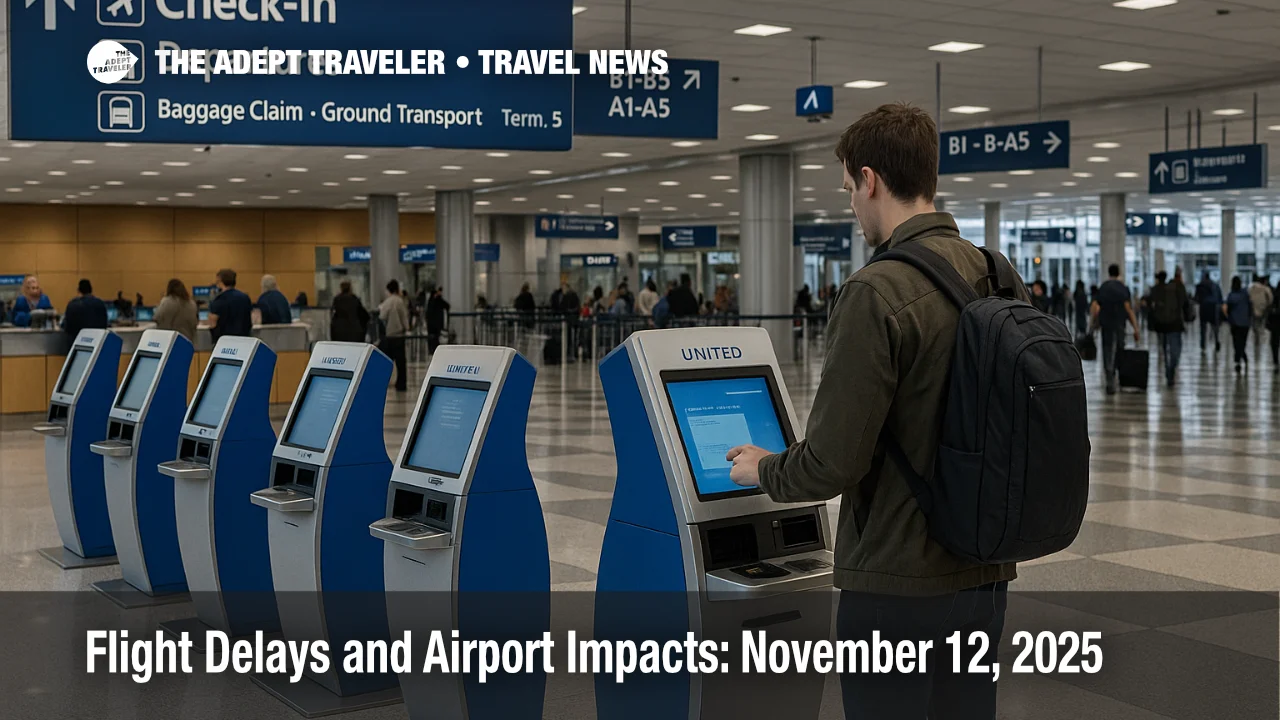Flight Delays and Airport Impacts: November 12, 2025

Key points
- ATCSCC plans an SFO ground delay program after 10:30 a.m. PT with low ceilings and strong south winds
- A possible Newark program after 1:00 p.m. ET may ripple through the New York area
- More than 850 U.S. flights were canceled by early morning with further cuts expected as schedules adjust
- Runway and taxiway work continues at multiple hubs including Boston, Orlando, and Chicago O'Hare
- Airspace routing initiatives are planned later today for flows to and from Florida
Impact
- San Francisco
- Expect arrival and departure metering, longer taxi times, and missed connections in the afternoon
- New York Area
- Watch for pop-up holds or revised departure times to Newark in the early evening
- Nationwide Rebooking
- Use airline apps to rebook proactively when your itinerary shows a controlled program or equipment change
- Tight Connections
- Build extra buffers at hubs listed with construction or runway closures to avoid misconnections
- Florida Flows
- Later-day reroutes can add en route time for Midwest and Northeast flights bound for Florida
The Federal Aviation Administration's Air Traffic Control System Command Center expects a ground delay program at San Francisco International Airport (SFO) this afternoon due to low ceilings and strong south winds, with a possible program for Newark Liberty International Airport (EWR) in the early evening. Early counts show more than 850 U.S. cancellations as of about 5:00 a.m. ET, following 1,200 plus cancellations on Tuesday as carriers continue to align schedules with federal capacity limits. Travelers with tight connections through San Francisco or the New York area should add buffer time or rebook to earlier flights when available. Airlines are still trimming schedules, so same-day changes may appear with little notice.
FAA plan for today
The Command Center's current plan lists San Francisco as "ground stop or delay program expected after 1030 a.m. PT," driven by forecast ceilings and winds that likely force a 19 and 10 runway configuration. Newark is "ground stop or delay program possible after 100 p.m. ET," which can slow New York area flows and spill delay to LaGuardia and Kennedy even without formal programs there. A Philadelphia area staffing trigger was posted for the morning, but terminal initiatives were not expected for that window. Denver's 17L and 35R runway has reopened, easing earlier constraints.
The advisory also flags late-day airspace initiatives that may affect routes into and out of Florida, including Midwest to Florida and Ohio Valley to Florida flows, which can add airborne time or require reroutes. These tend to peak later in the day when traffic banks converge.
What the numbers say
By early morning, FlightAware counts showed more than 850 cancellations across, into, or out of the United States, with hundreds of delays already posted. On Tuesday, cancellations exceeded 1,200 nationwide as airlines implemented FAA-directed reductions and adjusted crew and fleet plans. Expect the totals to climb through the afternoon peak, especially if San Francisco's program extends, or if Newark moves from "possible" to "active."
Runways, equipment, and local choke points
Today's plan notes ongoing construction and closures that can shave usable capacity at several airports. Highlights include Boston Logan International Airport (BOS) runway 09 and 27 closed until November 15, Orlando International Airport (MCO) runway 18R and 36L closed until November 14, Tampa International Airport (TPA) multiple runway closures through November 19, and east taxiway construction at Chicago O'Hare International Airport (ORD). Seattle-Tacoma International Airport (SEA) also lists Time Based Flow Management implementation through early morning, with taxiway construction continuing into December. Any of these can compound routine weather or volume delays during banked periods.
Analysis
San Francisco's expected program will likely meter inbound traffic in 10 to 20 minute chunks, then propagate outbound pushbacks and missed connections. If you are connecting at San Francisco this afternoon, move to an earlier inbound if seats exist, or shift to a longer connecting window. For Newark, monitor airline pushes that swap aircraft or retime flights between 100 p.m. and 500 p.m. ET. If a program posts, departure times are often reassigned automatically, so rebook options can disappear quickly once slots are reallocated.
Background
Ground delay programs meter arrivals to match reduced airport acceptance rates. Causes include ceiling and visibility reductions, strong winds that force less efficient runway configurations, short staffing, or runway and taxiway outages. The Command Center issues time-stamped advisories and adjusts programs through the day as weather and capacity change. You can cross-check national status on FAA's NAS Status site, then confirm airline-specific waivers and rebooking terms in your app before heading to the airport.
Final thoughts
Today's headline risk centers on San Francisco's weather-driven program and a possible Newark program, with national cancellations still elevated after Tuesday's reductions. Build slack into connections, use mobile boarding pass notifications, and rebook early if your itinerary touches either hub during the listed windows. "Flight Delays and Airport Impacts" will remain the key phrase to watch as the FAA plan updates through the afternoon.
